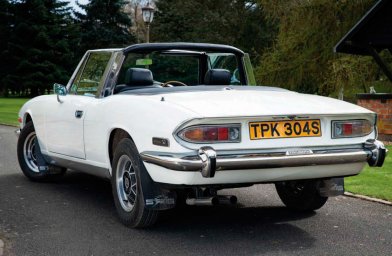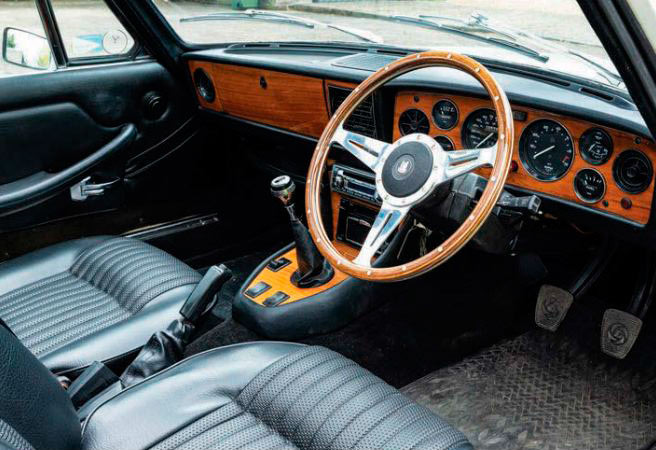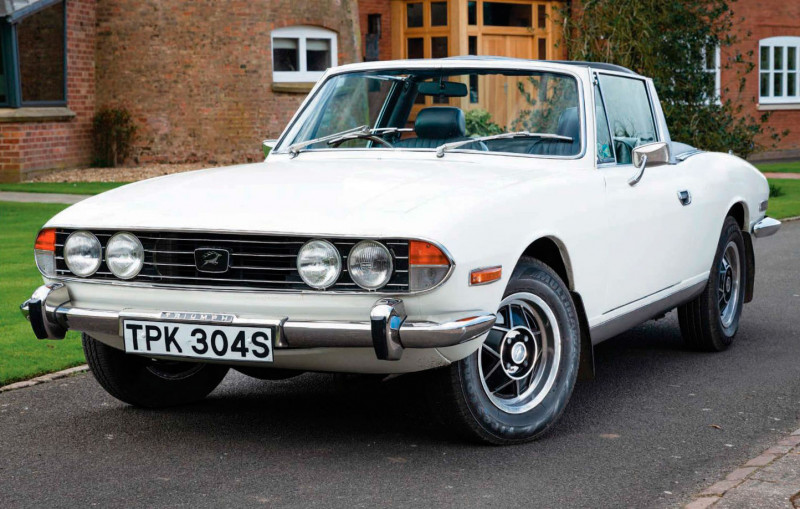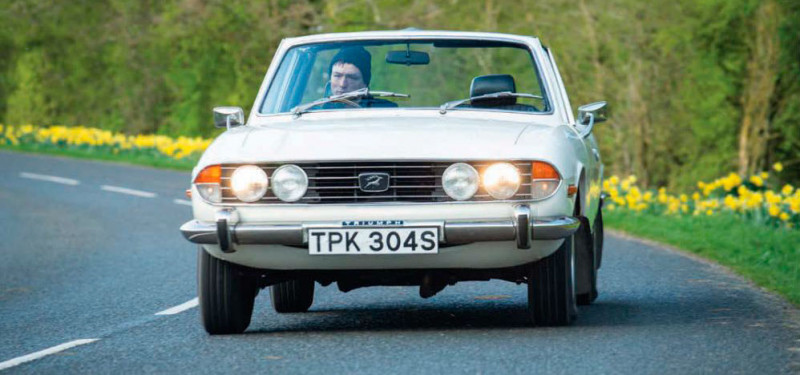1970 Triumph Stag 3.0 V8

Cool Runnings Did the Stag deserve its reputation? We revisit the British answer to the SL and find out. We revisit the only V8 Triumph and discover just how unfair history has been to BL’s answer to the Mercedes SL… Words: Aaron McKay. Photography: Gregory Owain.
CLASSIC ROAD TEST: Triumph Stag 3.0 V8
Much-discussed engine issues can be largely forgotten these days.

Triumph had wanted to sell 12,000 Stags a year but after seven years less than 26,000 were made. The export market, where Triumph had hoped 50 per cent of sales would go, was even worse. It wasn’t just the reliability woes we’ve forever heard about, it was that these were compounded by the fact the Stag already had everyone looking at it in the first place. When what they were talking about changed from how stylish it was to how disastrous it could be, its fate seemed sealed. However, those initial feelings towards the Stag would ultimately secure it a new fate much further down the road.

Enter the enthusiast. Many people still wanted a Stag, so would do what it took to make it happen. The risk was worth the reward, even if that led to big bills, or even complete engine swaps.
Today the commitment to Stag maintenance and restoration continues, usually with a strong focus on originality – few engine swaps these days – and supported by increasingly large cheque books. Nearly half of all Triumph Stags sold in the UK are still in existence, so there must be something about it.
The Stag enjoys two fundamental qualities of any desirable car: looking good and sounding good. The first is unsurprising when you learn that the shape was conjured up by Michelotti with some spare time. He wasn’t under commission, instead he had worked up a sporting version of the 2000 saloon as a demonstration of what his design studio could do. The body was set lower, particularly at the shoulder line, and its profile was much sleeker thanks to its two-door format and little details like the flat wheelarches.

Fortunately for all of us, Harry Webster, Triumph’s Director of Engineering at the time, viewed it during a visit to Michelotti’s Turin workshop in early 1966 and immediately expressed an interest for it as a production Triumph, the company taking up the option which had previously been agreed.
It would have sounded good with a Triumph six or a Rover V8, both of which were considered to some extent during its development stages. But it was the V8 of the new Triumph engine range that would ultimately see exclusive fitment in the Stag, and in retrospect I think most wouldn’t have it any other way.
With a capacity of 3.0-litres, it produced 145bhp and a hefty 167lb.ft of torque, and would have produced even more had it not been for the decision to ditch the Lucas injection in favour of more US-friendly Zenith- Stromburg carburettors.
In fact, US-specified cars produced even less power, much like the contemporary TR6s.
Against a new generation of fuel injected engines, particularly those from the continent, the Stag didn’tlook like much of a performance car, but its best feature was, anyway, the sound.
And it’s the sound that I’m looking forward to most as I twist the key in this exceptional, manual-gearbox car today. It fires up remarkably smoothly, almost disappointingly so, despite having to twist on the choke in the early April chill. A prod of the throttle wakes up the unmistakeable light rumble of eight cylinders less than 375cc each. It has as heavy a flywheel as you’d expect and there’s a classic boominess from the exhaust, but it takes just one prod to know that there’s something special about a Stag’s V8.
The reinforced gearbox for the Stag is just as sweet as in any other Triumph. Such is the Stag’s torque you short-shift lazily into second fairly early on, and third follows just as easily. The pedals, too, offer smooth but positive engagement. The seating position is more 2000 than TR4 but so too is overall comfort.
You may sit a little high but the seat is nicely shaped, if a little springy, and there’s plenty of space – no having to hang the arm out the window here.
With that big rotary headlight switch on the steering column I set the dipped beam on, and get some warmth going with the relatively clear heater controls. It feels cosy and civilised, but whirlwinds of air soon take over the cabin once you get anything about 30mph.
To stop the V8 fading into the rush of wind above, you can lean into the throttle to find a deeper, louder note as it slurps more fuel. It quickly turns much more sporting, something more tenor than bass. It almost howls, but more offbeat than a V6, and before you know it you’ve reached the end of the tachometer.
Its full 145bhp is reached at 5500rpm but it feels evenly strong all the way from its torque peak of 167lb.ft at 3500rpm. Kept in the mid-range it’s an audible delight to squeeze the V8’s tune out between corners, and it’s smooth enough to forget about the overdrive.
It rides smoothly too. Most of the time the Stag glides along knobbly B-roads, soaking up little bumps and cracks in the surface. Only the worst bumps, particularly if wide enough to affect both wheels of an axle, will upset it. It’s on these occasions that you might get a shimmy through the roof, or a couple of squeaks from the hardtop’s mounting points. With the roof down the Stag feels solid and, generally, very planted. The steering is accurate and even offers a decent amount of feel, despite the standard fit power assistance. There’s a degree of body roll when you’re cornering at a fast cruise, more obvious because of the almost flat bonnet ahead of you, but it finds a good footing and enjoys being driven out under throttle.
There’s not a huge amount of grip and the brakes can sometimes feel a little overwhelmed when you get carried away with the engine, but overall there’s enough roadholding to have fun, even on roads greasy with fine rain or, as in our case, confused with hail, snow and sunshine. As a car to sit in, it’s rather pleasant. Despite being trimmed almost identically to the later 2000 and 2500 saloons, there’s a sense of the Stag being something a bit exotic. After all, the big Triumphs are hardly spartan, but it’s more than the veneered dashboard, textured vinyl and plentiful instruments.
There is of course the T-bar which is part of the Stag’s unmistakable character visible from inside and out. The dash is ever so slightly more sculpted and the long door cards have an upmarket, rather Italian style. It’s a shame that some of the materials and switchgear don’t quite reach the same heights that the glamorous exterior promises in terms of richness and quality of operation.
There’s much to love about the Stag. Its engine never gets old, only empty of fuel. Its handling has enough for the ex-TR man to not be too disappointed, and there’s a ride quality plenty smooth for the family to enjoy the other three seats. It is, we know, a fantastic looking thing too. You can pick faults, but the mechanical ones now all have solutions, and the interior is far from disappointing – if it really is, then you may need a Mercedes SL.
But the Stag offers something that can shrink its faults. Engines can be fixed, dashboards can be re-veneered, bodies can be repainted. What can’t be replicated is the character of the Stag. Something that from beginning to end was an enthusiast’s car, built as something a bit special.
That’s why the Stag is up there with some of the most iconic classic cars, and why I enjoyed the drive so much despite the roof being down in the middle of April’s cruel snow.
SPECIFICATIONS
- ENGINE 2997cc V8
- MAX POWER 145bhp at 5500 rpm
- TOP SPEED 118 mph
- 0-60MPH 10.4 secs
- ECONOMY 20 mpg
- GEARBOX Four-speed o/d or three-speed auto
- LENGTH 4.41 m
- WIDTH 1.61 m
- WEIGHT 1197 kg
The T-bar was added primarily to ensure rigidity as well as meet feared US-market regulations.
Michelotti’s conversion of 2000 saloon to elegant open grand tourer was a neat piece of work.
Interior is derived from the saloon but with extra touches of style.
The Stag is brisk enough to be fun, but remains more civilised than any of the TRs.

